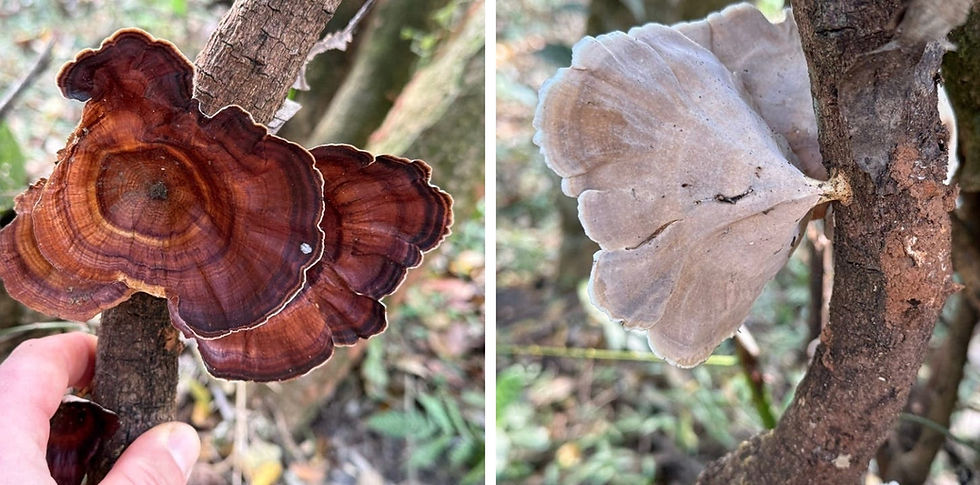Mushroom Masala - Mushrooms of South India's Dry Season
- Aubrey
- Feb 12
- 5 min read
Hey gang,
It’s 3:30 AM and I’m at the Bangalore airport. The architecture is tasteful, lots of natural materials and green walls. We just spent the past ten days in South India which, as we were told on multiple occasions, might be the shortest amount of time anyone has ever committed to traveling through the area. That said, we crammed a lot in and felt like it was a great introduction to this vast, diverse country.

We spent a few days at a home-stay in the mountains in Wayanad (near the Nagarhole Tiger Reserve), five days at a yoga Ashram, and another couple days in the city of Mysore. When we arrived at the yoga Ashram one of the first people we saw - and the first American we’d met the whole trip - was someone who attended a mushroom walk I led this summer. Shoutout Juli from the New York Mycological Society.
We had a few random, chance encounters like that throughout the trip (we randomly ran into a guy in the city of Mysore that we’d met a week earlier at the home-stay, Ciara got hit by a golf ball while we were in a rickshaw). There’s definitely something in the air down here (aside from the pollution😅).

It’s the dry season here so fresh mushrooms are at a premium. We really only found them popping up in areas that had been irrigated. The rains start in June and run through September, but they’ve become a little more unpredictable in recent years per the locals. This trip wasn’t specifically for mushrooming, I opted instead to experience caffeine withdrawals at a yoga Ashram, but I’m already ruminating on how I can spend a few months here looking for and learning about mushrooms during the monsoon season.
In lieu of fresh mushrooms, lots of locals eagerly talked about their experience with mushrooms. Mushroom curries are a daily dish during the rains. Tribal folks will harvest mushrooms that grow in termite mounds and use them medicinally (backed up by a formal study, Reference 1). Lots of people flock to Kodaikonal in the fall to find magic mushrooms growing in elephant and gaur dung. There’s even a newly-formed mushroom festival in South India. The mushroom culture is definitely here, my timing was just a few months early.

India is rich in animal diversity. The birds were ornate and colorful, and there’s quite a bit of “charismatic megafauna”. Elephants, tigers, leopards, monkeys, sloth bears, gaur, peacocks all inhabit the forests of South India (you can see rhinos in a few spots in the north) . Even their squirrels are giant.

The one anti-mushroom sentiment I actually came across was at the yoga Ashram. According to their Ayurvedic teachings, mushrooms are considered Tamasic which means they cause lethargy or inertia. This is because they tend to grow in the dark from dead material - real earthy, “Kapha” fare. Definitely something I’ll have to read more about.

We were able to go for a “trek” (a hike) up the Brahmagiri Hills which is where I found most of the mushrooms on the trip. An interesting aspect to trekking here is that you need a guide to take you up the mountain. It makes sense since there are tigers and elephants in the forest, and none of the trails are marked. Our guide didn’t speak a lick of English and hiked the whole thing in flip flops which was sweet.
Here are some mushrooms from the trek and the rest of our time in India:
Yellow Stemmed Micropore (Micropus xanthopus)

Dark-footed tinypore (Micropus affinus)


Splitgill mushroom (Schizophyllum commune)

Yellow-staining Agaricus (Agaricus spp.)

Earliella scabrosa

Brooklyn Winter Fungi Festival
I will be in Brooklyn on 3/1 for the New York Winter Fungi Festival. Tickets are free (unless you want to go the VIP route). I’m just going to be hanging out, talking shop, and taking in the presentations/panels so it’d be great to see some of you.
I have something pretty neat planned for next week’s article during our extended layover in Paris. Stay tuned.
Aubrey
Bonus Stripe-necked mongoose picture (Urva vitticolis)

References:
Paloi S, Kumla J, Paloi BP, Srinuanpan S, Hoijang S, Karunarathna SC, Acharya K, Suwannarach N, Lumyong S. Termite Mushrooms (Termitomyces), a Potential Source of Nutrients and Bioactive Compounds Exhibiting Human Health Benefits: A Review. J Fungi (Basel). 2023 Jan 13;9(1):112. doi: 10.3390/jof9010112. PMID: 36675933; PMCID: PMC9863917.
